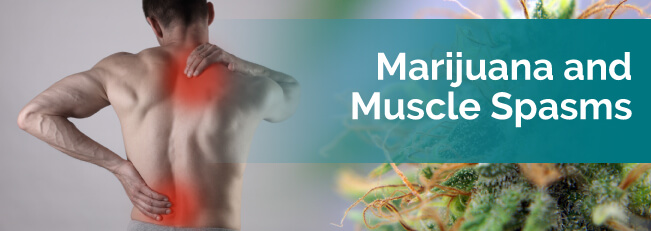
Muscle spasms affect just about everyone, from foot cramps and midnight “charley horses” to strained and pulled muscles. Certain disorders and diseases also cause muscle spasms. Multiple Sclerosis (MS) and Amyotrophic Lateral Sclerosis (ALS) can all cause patients to experience muscle spasms that range from uncomfortable to painful.
Treating these diseases, as well as the common causes of muscle spasms, often means patients must rely on traditional prescription medicine or homeopathic treatments, such as changes to your diet to reduce the chance of muscle cramps. In some cases, especially with neurological diseases, traditional prescription drugs fail to alleviate or reduce muscle cramps for some patients.
Because of this, medical marijuana has become an increasingly popular option and an alternative to traditional prescription medicine, especially in states where medical marijuana is now legal. It’s also a more natural and effective alternative to everyday spasms or common muscle injuries, where opioids may be used for treatment.
Learn more about medical marijuana for muscle spasms and why it’s an effective treatment below.
Patients response to medical marijuana is why it’s approved for treating muscle spasms in many states across the U.S.
States, such as Alaska, Connecticut, Pennsylvania and others approve using medical marijuana for muscle spasms caused by an underlying condition, such as MS. Certain states, like Massachusetts, also allow medical cannabis for muscle cramps if your physician recommends it.
Marijuana works by reducing inflammation, which causes muscle spasms. A study by the University of South Carolina found that the immune system’s response, such as to a muscle injury, is reduced and the systems inflammatory proteins are deactivated by psychoactive THC, a cannabinoid.
THC also influences the endocannabinoid system (ECS), which is a network of cell receptors throughout your body that impact your feelings of pain, which can result from inflammation in the case of muscle spasms.
When medical marijuana is used, cannabinoid receptors in your ECS bind with THC and CBD, another cannabinoid. By binding to cannabinoid receptors, THC starts an anti-inflammatory response which prevents inflammation and muscle spasms after an injury, for example.
A study on MS, which is characterized by inflammation that damages nerve fibers, also confirmed that medical marijuana relieves inflammation. The 2013 study demonstrated that THC and CBD reduced the phenotype responsible for inflammation in MS.
Studies on the effectiveness of medical marijuana on muscle spasms tend to center on its use on muscle spasms caused by an underlying condition like MS due to the prevalence of these illnesses, as well as the fact that muscle spasms are often not chronic and are usually curable.
Another MS study on muscles spasms found an oral cannabis extract improved patient’s spasticity, or muscle cramps, at twice the rate of the given placebo, while another research effort featured more than 500 subjects. More than half of the testers reported more than a 20 percent improvement in spasticity after a month of treatment with Sativex, an oral cannabis spray produced by GW Pharmaceuticals.
As more pharmaceutical companies become involved in producing and distributing medical marijuana, it’s expected more research will be conducted about how and why medical cannabis affects chronic muscle spasms caused by issues unrelated to diseases like MS, such as muscle injuries.
Marijuana’s proven efficacy for treating inflammation and muscle spasms makes it a viable and ideal treatment option for patients, which is why so many states have approved its use as a treatment option for muscle cramps.
Find A Doctor Find A Dispensary
Medical marijuana for muscle spasms varies in its treatment and application. It can be smoked, eaten or applied as a topical depending on your muscle spasm, as well as the type of medical cannabis strain you’re using for treatment.
Topical medical cannabis creams for muscle cramps are an effective treatment. Because activated marijuana, when used as a topical, numbs a localized area, it can numb your spasm and ease your muscle out of its contraction. When you use a topical medical marijuana cream, wait 30 minutes between applications. You can also massage the area or stretch the muscle to help relieve your muscle spasm faster.
Localized treatments also help your immune system respond more efficiently to your muscle injury by influencing your white blood cells reaction via your ECS receptors, which helps you heal faster and lets you resume your daily life quicker.
Several different strains of medical marijuana for muscle cramps are available in indica, hybrid and sativa strains. In fact, more than 300 strains are approved for muscle spasm use. Each strain has unique characteristics. Sativa, for example, is an invigorating strain, while indica relaxes and hybrids provide a unique experience that’s influenced by its parent strains.
Popular medical marijuana strains for muscle spasms include:
Head Cheese is a potent hybrid strain of 707 Headband and UK Cheese. It has a high THC content, which can cause a psychoactive effect, but its effectiveness on pain, muscle spasms and inflammation is substantial. Head Cheese has a cheesy, earthy and pungent flavor.
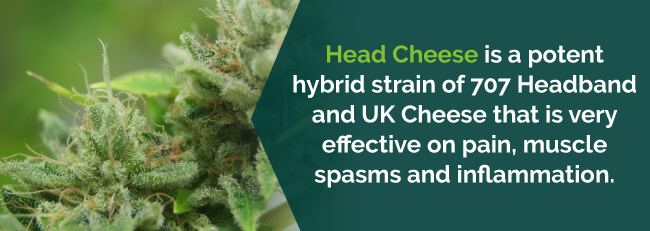
Snoop Dogg is an indica strain that takes its name from the well-known rapper. The strain has a strong diesel flavor, as well as an earthy and lemon taste. It relieves muscle spasms, pain and stress.
Green Candy is a hybrid marijuana strain. It’s a cross of Candy Kush and Green Crack with a sweet, earthy and pine flavor that relieves your muscle spasms, pain and stress. The hybrid strain is also useful for treating nausea.
The Hog is an award-winning medical marijuana strain and one of the strongest cannabis strains in the world. Due to its strength, it’s dosage is heavily monitored, but it’s effective in relieving muscle spasms, inflammation and pain. The Hog’s flavoring includes an earthy, woody and sweet taste.
Side effects of medical marijuana do occur but are minimal in comparison to the potential effects of prescription drugs for muscle spasms. Common side effects of medical cannabis include:
Many of medical marijuana’s side effects can be limited or reduced based on the strain of cannabis you choose to use for your muscle spasms. When you meet with a licensed physician, talk to them about finding a strain that treats your symptoms with minimal side effects.
Choosing a strain and dosage amount should also be discussed between you and your medical marijuana doctor. As you try strains, keep a log noting their effect on your symptoms as well as your overall disposition. A symptom log is often helpful for physicians and patients when determining which strains and dosages work best.
It’s also recommended to continue other treatments, such as physical therapy, alongside your use of medical marijuana. Physical therapy can help prevent the shortening of your muscles and maintain full muscle movement or joint rotation.
As the studies mentioned earlier noted, medical marijuana is an effective treatment method for muscle spasms caused by MS, an immune-mediated disease.
If you’re unfamiliar with MS, it’s a debilitating and sometimes fatal disorder of the central nervous system and is the most common debilitating neurologic disease of young people. More than two million people worldwide suffer from the disease, with two hundred new cases diagnosed in the United States every week.
Prescription treatments for MS’ muscle spasms can cause side effects that reduce white blood cell counts, as well as lead to hair loss, lower heart rates and more, which is why medical marijuana is becoming a viable, and safer, treatment option for MS patients with muscle spasms.
MS patients who use medical marijuana for multiple sclerosis have a variety of options, including smoking, edibles, vaping (using a vaporizer) and others. One of the most popular methods for sufferers of the disease is the use of cannabidiol, or CBD, which is a non-psychoactive chemical found in cannabis.
CBD oil — typically taken in the form of a mouth spray — has increased in acceptance, and is available in many different countries. Patients not only report a decrease in spasticity and muscle spasms, but also sleep disturbances as well as pain. Although administration of CBD through mouth spray is popular, vaping cannabis high in CBD can also help relieve pain and other symptoms.
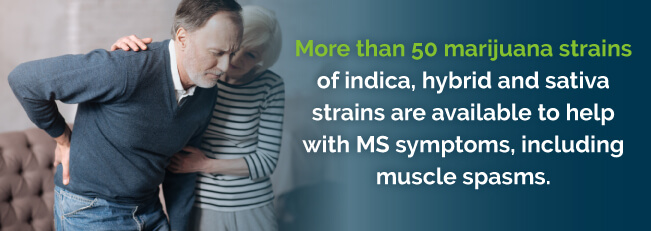
More than 50 marijuana strains of indica, hybrid and sativa strains are available to help with MS symptoms, including muscle spasms. Patients can also take advantage of the general muscle spasm strains available, but the strains specific towards MS treat muscle spasms and additional symptoms of the disease.
Popular medical marijuana strains for MS’ muscle spasms include:
Your licensed medical cannabis doctor will help you select strains, as well as work with you to find a strain that meets your needs and makes you comfortable. As states continue to legalize medical marijuana, many are setting aside funds for researching its uses and applications, which means future strains will likely be targeted or developed for select diseases or symptoms, like MS or muscle spasms.
Cannabis has therapeutic effects for millions of people and doctors should have the freedom to prescribe cannabis to the individuals who will benefit. Many marijuana states have approved the use of medical marijuana for severe muscle spasms, as well as conditions that can cause frequent muscle cramps.
Medical cannabis is an affordable, natural alternative medicine that has helped thousands of multiple sclerosis patients. If you or someone you love is suffering from severe muscle spasms and you’d like to find out if medical marijuana is the right treatment, MarijuanaDoctors.com can help.
We can connect you with hundreds of quality marijuana doctors across the country in all legal marijuana states and ensure you are in compliance with your state laws, as well as find a dispensary. Book an appointment today and let us help improve your quality of life!
You can also learn more about medical marijuana for muscle spasms and other conditions, as well as new cannabis research, by signing up for our newsletter.
For more information about how cannabis can be used to treat Muscle Spasms, check out our resources:
Find A Doctor Find A Dispensary
Muscle spasms or cramps are common, though people who are older and overweight are at a greater risk. Athletes, due to their physical activity, are also at an increased risk for muscle spasms with 67 percent of triathletes experiencing muscle cramps.
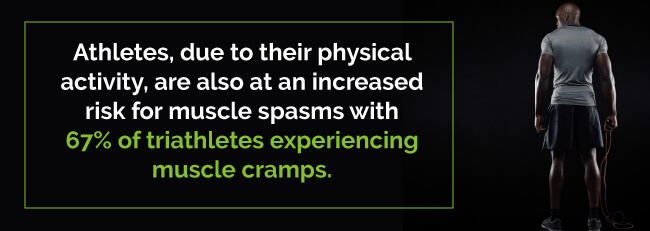
Spasms can last a few seconds, a few minutes or even hours in some cases. They typically occur in your legs, but can also affect your arms and back, and any other muscle throughout your body. Intense spasms can cause also cause tears in your tendons or ligaments, especially if the tissue is already weakened or partially torn.
Persistent, reoccurring spasms can also cause soft tissue to shorten, which can cause affected muscles to become rigid, difficult to use and prone to injury. A permanently stiff joint, such as in the hip, knee, shoulder, ankle or elbow is debilitating and prevents many individuals from leading the life they want.
Muscle spasm symptoms focus on a pain that’s sudden and usually brief, though it can last longer. Muscles affected by the cramp also feel tight and are tender to the touch, and can bulge. Locations of spasms are also easy to pinpoint due to the level of pain but can be misinterpreted based on their location.
A headache, for example, can actually be a spasm in your neck, while a tightening of your chest could be a pectoral cramp. If you do feel tightness in your chest though, you should not hesitate to seek medical attention, as it could be signs of a more serious event like a heart attack.
Numerous triggers cause the symptoms of everyday or reoccurring muscle spasms. Dehydration from working outdoors or running a marathon can cause a muscle spasm, as well as the inflammation from a muscle injury, such as a torn or stretched muscle.
Additional triggers for muscle spasms include:
Muscle cramps are categorized into a few different categories, which are often used to diagnose a spasm if it’s reoccurring. Spasm types include:
Hypertonic muscle spasms are characterized by a constant contraction of the muscle, which is also described as extreme muscle tone or residual tension. These spasms are also known as over-active or spastic muscle spasms and do not always cause the pain associated with cramps, though they are still straining the muscle.
True hypertonic spasms result from damaged or malfunctioning feedback nerves that prevent muscles from relaxing. Because damaged nerves cause a true hypertonic spasm, rather than overexertion during exercise, it requires continuous medical treatment.
Stomach spasms are a type of spam that results from chronic inflammation, obstruction or distention in the stomach. Chronic conditions like Irritable Bowel Syndrome (IBS) often cause stomach spasms. Infants with colic also experience abdominal cramps.
Angina is a muscle spasm that results from the heart not receiving enough blood, which can be caused by heart disease and the hardening of arteries or atherosclerosis. Spasms from angina are felt in the chest, neck, shoulders and jaw.
Muscle spasms tend to be loosely categorized because they’re common and often don’t require medical treatment. Severe or reoccurring muscle spasms, such as those caused by MS, true hypertonic spasms or muscle injuries, however, need treatment.
Everyday muscle spasms often rely on at-home treatments, such as stretching and massaging the area to relieve the cramp. Patients who rely on prescription treatments for muscle spasms have a muscle injury or underlying disease or illness.
Prescription treatments for muscle spasms include Cyclobenzaprine, Tizanidine, Baclofen and numerous other drugs. Potential side effects of these drugs include:
Additional non-prescription treatments for muscle spasms include changes to your diet, physical therapy, stretches and massage and tend to have positive side effects. These natural treatments often occur in coordination with a prescription drug treatment for patients with frequent muscle spasms.
Muscle injuries may be prescribed medicine to relieve the spasm, as well as opiates for chronic pain resulting from the injury. Because opiates are best for intense, short-term pain that results from surgery, broken bones or any other severe accident, they’re not appropriate for reoccurring, chronic pain.
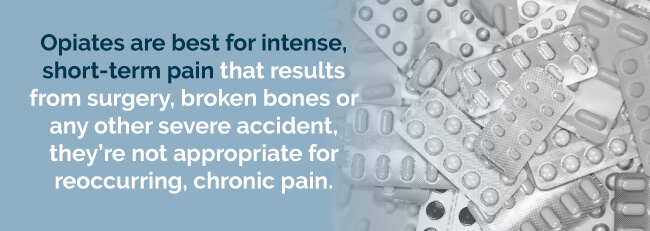
An estimated 90 percent of patients are prescribed opioids for their chronic pain, yet research has found natural treatments provide the same relief, without the health or addiction risks of opioids. Opiates also cause side effects such as drowsiness, nausea, constipation and liver or brain damage, as well as tolerance to the drug. Addiction is also a risk, as more than 2 million Americans abuse prescription painkillers.
As noted earlier, certain drugs can cause muscle cramps as a side effect, which leads to a potential scenario where you may be given multiple drugs — one to treat your initial symptoms and a second to address that drug’s side effects. Medicines that can cause muscle spasms include:
These prescriptions are used to treat high blood pressure, cholesterol, asthma, Parkinson’s Disease and Alzheimer’s. While your doctor can prescribe a different drug for treatment to stop your spasms, a viable alternative prescription may be unavailable for some patients.
Medical marijuana is a safe and natural medicine for treating muscle spasms, with minimal side effects. It’s capable of treating cramps caused by an underlying disease, other prescriptions or muscle injuries, which is why numerous states have approved it for treating muscle spasms.